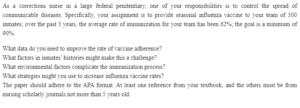Community Health Nursing-Influenza Vaccine Administration
Nurses play a role in the community by providing care to people. They work with the school nurses, families, students, and the elderly to meet the goals of community health nursing. Community health nursing helps to keep the nation healthy since public health nurses work from the grass root levels. They work with people of different ethnicities, ages, social and economic groups (Allender et al., 2013). Their goal is to emphasize on prevention of communicable diseases by administration of vaccines.
To improve the rate of adherence to the influenza vaccine, data records are very important. Data on who has received, who has not received influenza records should be revisited every time, especially for the cases of inmates. Interaction rate in prisons is another factor. The rate of social interaction is very high. This poses a threat to the health of the inmates, the staff, and the correctional nurses since influenza is a communicable disease.
There are factors in an inmate’s history that may hinder the attainment of at least 90 percent influenza vaccine administration. There inmates that have underlying conditions. Some of these conditions include sexually transmitted diseases, hepatitis, and the human immunodeficiency virus (Martins et al., 2018). This is because most of these inmates report having cases of assault and rape before. Therefore vaccine administration among people with these conditions may worsen their states. Some have health problems such as drug or medication allergies, and some have kidney failures and hepatic failures because of intense alcohol consumption. Administration of vaccines to people with system failures may cause toxicity and can lead to death.
Environmental factors that complicate the immunization of inmates include insecurity. In prison, some inmates are very hostile and non-compliant when they see medical personnel. This could be because of mental issues such as stress and depression. Some of these inmates are very manipulative, complicating the immunization process (Berry-Dee, 2017). The authorities or cell officers also manipulate the medical personnel, in this case, the nurses. They want a favor done for them to let the nurses immunize the inmates. Overcrowding is another factor that may hinder the immunization process. Most prisons are reported to be overcrowded such that the control of a communicable disease becomes a difficult job (Lugo & Wooldredge, 2017). Those immunized and have a phase re-infection, still mix up with those who have not received the vaccine. This makes a new strain of influenza, making it hard to manage.
Strategies to Improve influenza vaccine rates include training more correctional nurses. Even though working with inmates may be difficult because of their personality traits, there is a need to train nurses on mental health skills. They should also be trained on how to handle non-compliant, hostile, and manipulative inmates and officers. They should be trained on knowledge flexibility when addressing the inmates to improve the health outcomes. The other strategy is taking part in prison policymaking. This helps to regulate cases of overcrowding in cells. When overcrowding is controlled, then the spread of communicable diseases is minimized, and the number of people with underlying conditions is reduced.
In conclusion, to meet the goal of at least 90 percent immunization, there is a need to consider all the hindering factors, and environmental factors. To add on, strategies should be established to help in attaining the goal.
References
Allender, J., Rector, C., Rector, C., & Warner, K. (2013). Community & public health nursing: Promoting the public’s health. Lippincott Williams & Wilkins.
Berry-Dee, C. (2017). Talking With Psychopaths and Savages-A Journey into the Evil Mind: A chilling study of the most cold-blooded, manipulative people on planet earth. Kings Road Publishing.
Lugo, M. A., & Wooldredge, J. (2017). Overcrowding in prisons. The encyclopedia of corrections, 1-8. https://doi.org/10.1002/9781118845387.wbeoc163
Martins, D. C., Pesce, G. B., Silva, G. M. D., & Fernandes, C. A. M. (2018). Sexual behavior and sexually transmitted diseases among the female partners of inmates. Revista latino-americana de enfermagem, 26. https://doi.org/10.1590/1518-8345.2568.3043
ORDER A PLAGIARISM-FREE PAPER HERE
We’ll write everything from scratch
Question
As a corrections nurse in a large federal penitentiary, one of your responsibilities is to control the spread of communicable diseases. Specifically, your assignment is to provide seasonal influenza vaccine to your team of 500 inmates; over the past 3 years, the average rate of immunization for your team has been 62%; the goal is a minimum of 90%.

Community Health Nursing-Influenza Vaccine Administration
What data do you need to improve the rate of vaccine adherence?
What factors in inmates’ histories might make this a challenge?
What environmental factors complicate the immunization process?
What strategies might you use to increase influenza vaccine rates?
The paper should adhere to the APA format. At least one reference from your textbook, and the others must be from nursing scholarly journals not more than 5 years old.

